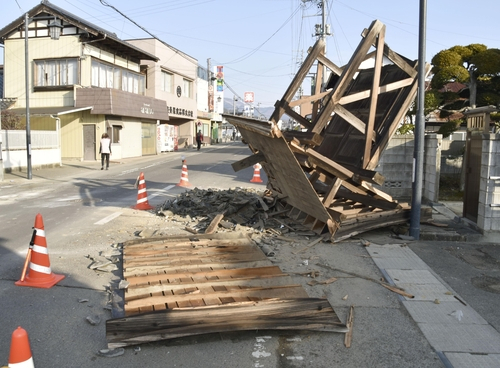Similar to the Great East Japan Earthquake, such as the time of occurrence, intensity, and location
Not enough to alleviate anxiety despite the announcement of “No Tsunami”
Suga to the official residence in 20 minutes… Emphasizes quick response
 viewer
viewer
On the 13th, a strong earthquake off the coast of Fukushima prefecture engulfed Japan’s Tohoku region in fear. With less than a month left for the 10th anniversary of the Great East Japan Earthquake (March 11, 2011), a strong seismic wave hit the areas of Fukushima Prefecture and Miyagi Prefecture, which were severely damaged at the time, and many citizens had to fall in fear.
The Japan Meteorological Agency announced that there was no risk of tsunami damage immediately after the earthquake, but it was not enough to alleviate the anxiety of residents who suffered a major disaster 10 years ago. The earthquake occurred amid increasing economic difficulties due to the new coronavirus infection (Corona 19), which aggravated anxiety.
The earthquake occurred on the 13th at 11:8 pm off the coast of Fukushima Prefecture. In Fukushima and Miyagi prefectures, the largest shaking of the’Jindo 6 River’ was observed. In the sixth round of progress, the shaking is so severe that it is difficult to stand properly. The earthquake is analyzed to be a type of aftershock of the Great East Japan Earthquake, and it was confirmed that more than 100 people were injured by the morning of the 14th. The timing, intensity, and location of the earthquake were all reminiscent of the Great East Japan Earthquake.
It has been almost 10 years since the earthquake of magnitude 7.2 (Jindo 6) in the offshore of Miyagi on April 7, 2011 that strong vibrations of the magnitude 6 or more were observed in Miyagi Prefecture. In the case of Fukushima Prefecture, the strongest vibration was observed this time since the Great East Japan Earthquake.
The Nihon Keizai newspaper (Nikkei) reported that there was a line of residents who took refuge in cars for fear of a tsunami in the highlands of Ishinomaki City in Miyagi Prefecture. Ishinomaki City is a basic municipality that suffered the most casualties from the tsunami during the 2011 earthquake. At that time, Ishinomaki’s death toll exceeded 3,500.
The authorities who were taking a break for the weekend also caught an emergency. According to Kyodo News, the Japanese government set up an official residence countermeasure room at the Prime Minister’s Office Crisis Management Center at 11:09 pm, one minute after the earthquake.
Japanese Prime Minister Yoshihide Suga, who spent the whole day at the lodge without an outside schedule, left the lodge 15 minutes after the earthquake. He arrived at the Prime Minister’s residence at 11:28, 20 minutes after the earthquake.
Prime Minister Suga ordered them to quickly grasp the situation and work closely with local governments to save lives and provide information. Japanese Minister Kato Katsunobu, who also plays the role of crisis management in the government, ran into the lobby of the Prime Minister’s residence about 10 minutes after Prime Minister Suga’s arrival and held a press conference at 1:14 am.
Prime Minister Suga held a brief press conference at 1:58 am in front of reporters waiting at the Prime Minister’s residence. He said, “There is no fear of a tsunami (earthquake and tsunami). There are no reports of abnormalities in all nuclear relations (facilities).” Prime Minister Suga convened related ministers at 9 am on the 14th to discuss earthquake measures.
It seems that the Liberal Democratic Party’s regime, which watched the ruling Democratic Party at the time of the Great East Japan Earthquake, and was being criticized by voters, was trying to highlight the situation that the government was responding quickly in situations that could lead to large-scale disasters such as earthquakes.
/ Intern reporter Park Shin-won [email protected]
< 저작권자 ⓒ 서울경제, 무단 전재 및 재배포 금지 >
